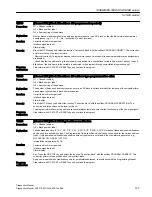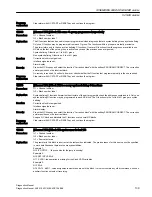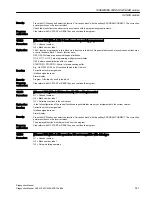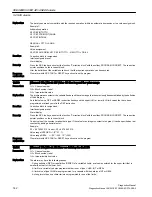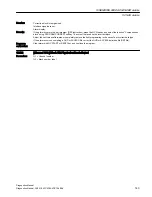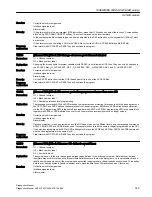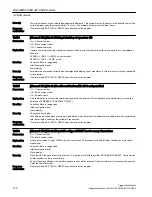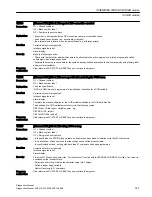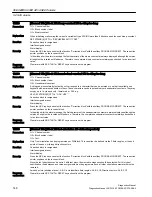
12000
[Channel %1: ] Block %2 address %3 programmed repeatedly
Parameters:
%1 = Channel number
%2 = Block number, label
%3 = Source string of the address
Explanation:
Most addresses (address types) may only be programmed once in an NC block, so that the block information remains
unambiguous (e.g. X... T... F... etc. - exception: G and M functions).
Reaction:
Correction block is reorganized.
Interface signals are set.
Alarm display.
Remedy:
Press the NC Stop key and select the function "Correction block" with the softkey PROGRAM CORRECT. The correction
pointer positions on the incorrect block.
- Remove from the NC program addresses that occur more than once (except for those where multiple value assignments
are allowed).
- Check whether the address (e.g. the axis name) is specified via a user-defined variable (this may not be easy to see if
allocation of the axis name to the variable is performed in the program through computational operations only).
Programm
continuation:
Clear alarm with NC START or RESET key and continue the program.
12010
[Channel %1: ] Block %2 address %3 address type programmed too often
Parameters:
%1 = Channel number
%2 = Block number, label
%3 = Source string of the address
Explanation:
The number of times each address type may occur in an NC block is defined internally (for instance, all axes together form
one address type to which a block limit also applies).
Reaction:
Correction block is reorganized.
Interface signals are set.
Alarm display.
Remedy:
Press the NC Stop key and select the function "Correction block" with the softkey PROGRAM CORRECTION. The
correction pointer positions on the incorrect block.
The program information must be split up over several blocks (but make sure that the functions are of the non-modal type!).
Programm
continuation:
Clear alarm with NC START or RESET key and continue the program.
12020
[Channel %1: ] Block %2 illegal address modification
Parameters:
%1 = Channel number
%2 = Block number, label
Explanation:
Valid address types are 'IC', 'AC', 'DC', 'CIC', 'CAC', 'ACN', 'ACP', 'CACN', 'CACP'. Not each of these address modifications
can be used for each address type. The Programming Guide specifies which of these can be used for the various address
types. If this address modification is applied to address types that are not allowed, then the alarm is generated, e.g.:
N10 G02 X50 Y60 I=DC(20) J30 F100
interpolation parameters with DC.
Reaction:
Correction block is reorganized.
Interface signals are set.
Alarm display.
Remedy:
Key: Press the NC STOP key and select the function "Correction block" with the softkey PROGRAM CORRECT. The
correction pointer is then positioned on the incorrect block.
Apply non-modal address modifications only for permissible addresses, in accordance with the Programming Manual.
Programm
continuation:
Clear alarm with NC START or RESET key and continue the program.
SINUMERIK 808D ADVANCED alarms
5.2 NCK alarms
Diagnostics Manual
Diagnostics Manual, 06/2015, 6FC5398-6DP10-0BA2
137















